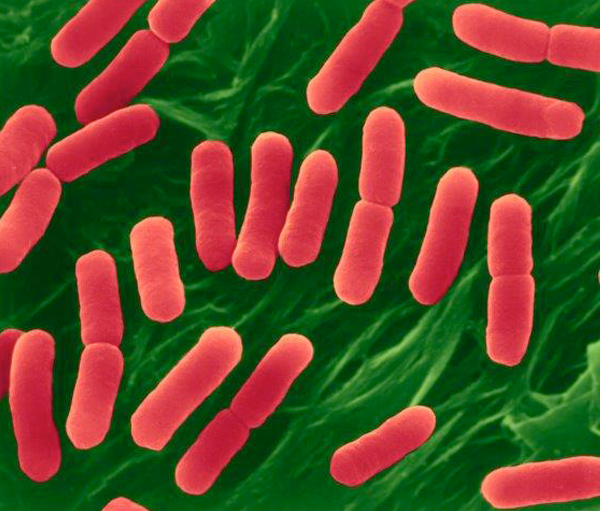
© Dennis Kunkel Microscopy
Home Resources Pathogens NON-O157:H7 STEC E. coli
NON-O157:H7 STEC E. coli

© Dennis Kunkel Microscopy
What are Shiga toxin-producing E. coli?
Some kinds of E. coli cause disease by making a toxin called Shiga toxin. The bacteria that make these toxins are called "Shiga toxin-producing" E. coli, or STEC for short. You might hear them called verocytotoxic E. coli (VTEC) or enterohemorrhagic E. coli (EHEC); these all refer generally to the same group of bacteria. The most commonly identified STEC in North America is E. coli O157:H7 (often shortened to E. coli O157 or even just "O157"). When you hear news reports about outbreaks of "E. coli" infections, they are usually talking about E. coli O157.
In addition to E. coli O157, many other kinds (called serogroups) of STEC cause disease. These other kinds are sometimes called "non-O157 STEC." E. coli serogroups O26, O111, and O103 are the non-O157 serogroups that most often cause illness in people in the United States.
Are there important differences between E. coli O157 and other STEC?
Most of what we know about STEC comes from outbreak investigations and studies of E. coli O157 infection, which was first identified as a pathogen in 1982. The non-O157 STEC are not nearly as well understood, partly because outbreaks due to them are rarely identified. As a whole, the non-O157 serogroup is less likely to cause severe illness than E. coli O157; however, some non-O157 STEC serogroups can cause the most severe manifestations of STEC illness.
Who gets STEC infections?
People of any age can become infected. Very young children and the elderly are more likely to develop severe illness and hemolytic uremic syndrome (HUS) than others, but even healthy older children and young adults can become seriously ill.
What are the symptoms of STEC infections?
The symptoms of STEC infections vary for each person but often include severe stomach cramps, diarrhea (often bloody), and vomiting. If there is fever, it usually is not very high (less than 101°F/less than 38.5°C). Most people get better within 5-7 days. Some infections are very mild, but others are severe or even life-threatening.
What are the complications of STEC infections?
Around 5-10% of those who are diagnosed with STEC infection develop a potentially life-threatening complication known as hemolytic uremic syndrome (HUS). Clues that a person is developing HUS include decreased frequency of urination, feeling very tired, and losing pink color in cheeks and inside the lower eyelids. Persons with HUS should be hospitalized because their kidneys may stop working and they may develop other serious problems. Most persons with HUS recover within a few weeks, but some suffer permanent damage or die.
How soon do symptoms appear after exposure?
The time between ingesting the STEC bacteria and feeling sick is called the "incubation period." The incubation period is usually 3-4 days after the exposure, but may be as short as 1 day or as long as 10 days. The symptoms often begin slowly with mild belly pain or non-bloody diarrhea that worsens over several days. HUS, if it occurs, develops an average 7 days after the first symptoms, when the diarrhea is improving.
Where do STEC come from?
STEC live in the guts of ruminant animals, including cattle, goats, sheep, deer, and elk. The major source for human illnesses is cattle. STEC that cause human illness generally do not make animals sick. Other kinds of animals, including pigs and birds, sometimes pick up STEC from the environment and may spread it.
How can STEC infections be prevented?
- WASH YOUR HANDS thoroughly after using the bathroom or changing diapers and before preparing or eating food. WASH YOUR HANDS after contact with animals or their environments (at farms, petting zoos, fairs, even your own backyard).
- COOK meats thoroughly. Ground beef and meat that has been needle-tenderized should be cooked to a temperature of at least 160°F/70°C. It's best to use a thermometer, as color is not a very reliable indicator of "doneness."
- AVOID raw milk, unpasteurized dairy products, and unpasteurized juices (like fresh apple cider).
- AVOID swallowing water when swimming or playing in lakes, ponds, streams, swimming pools, and backyard "kiddie" pools.
PREVENT cross contamination in food preparation areas by thoroughly washing hands, counters, cutting boards, and utensils after they touch raw meat.
Contact EHA Consulting Group today for more information about how we can assist your company.